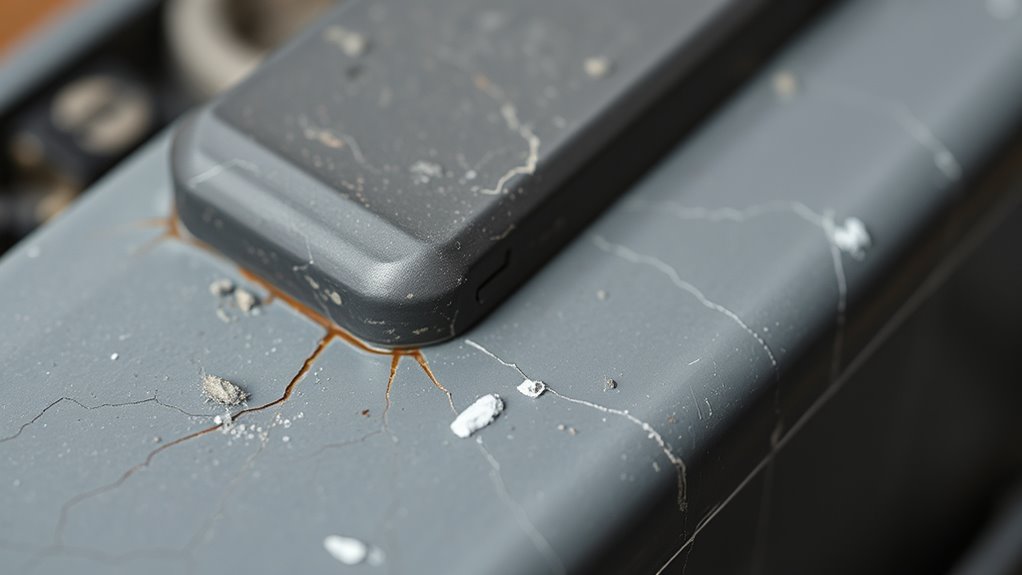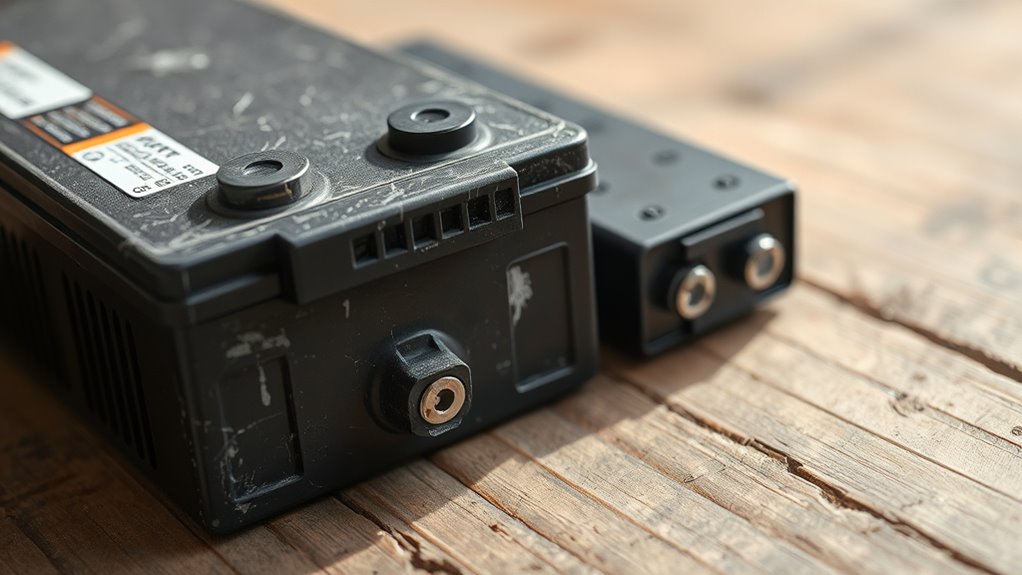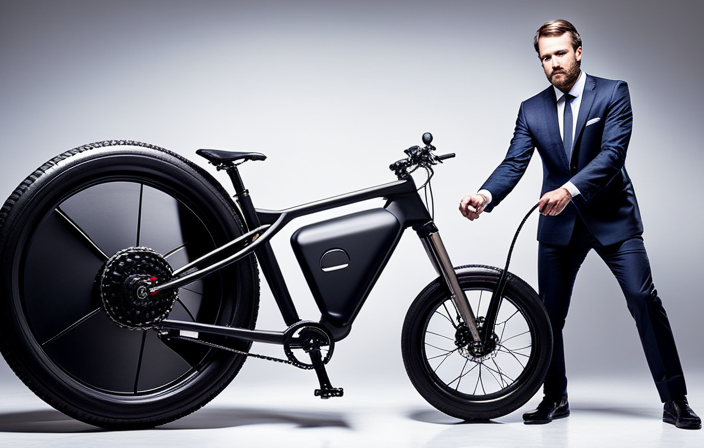E-bike batteries age because chemical reactions and physical stress damage their internal components over time, especially with heat, deep discharges, and fast charging. To slow this process, keep your battery between 20-80%, store it cool and dry, use compatible chargers, and avoid overcharging or leaving it at 100%. Proper care can markedly extend your battery’s lifespan. Still curious? Discover more ways to keep your battery healthy and riding farther.
Key Takeaways
- Battery aging is caused by chemical reactions, solid electrolyte layer formation, and structural breakdown from repeated charge cycles.
- High temperatures, deep discharges, and fast charging accelerate chemical degradation and capacity loss.
- Proper maintenance, avoiding overcharging, and keeping the battery between 20-80% extend lifespan.
- Storing batteries in cool, dry environments at around 50% charge slows aging processes.
- Advances like solid-state batteries and thermal management technologies aim to improve longevity and slow deterioration.
The Chemistry Behind Battery Aging

Understanding the chemistry behind battery aging is essential because it explains why batteries gradually lose their capacity over time. The primary cause is battery degradation, which involves changes in the electrochemical processes inside your e-bike’s battery. During charge and discharge cycles, chemical reactions occur between the electrolyte and electrodes, producing energy. Over time, these reactions cause the electrodes to degrade, forming solid electrolyte interphase layers or experiencing structural breakdown. This buildup hampers ion flow, reducing the battery’s efficiency. Repeated cycling accelerates this process, leading to diminished capacity and shorter ride distances. Additionally, temperature fluctuations can accelerate battery degradation, further impacting longevity. Recognizing the electrochemical changes involved helps in understanding how different factors influence battery lifespan. Variations in temperature can cause expansion and contraction of internal components, which also contribute to battery aging. By grasping these electrochemical changes, you can better appreciate why your battery’s performance declines and start considering strategies to slow this natural aging process.
Factors That Accelerate Battery Wear

Many factors can speed up the natural aging process of your e-bike’s battery, leading to quicker capacity loss and reduced performance. High temperatures, deep discharges, and frequent fast charging accelerate wear. Exposure to heat causes chemical reactions that degrade cells faster, while regularly draining the battery below 20% strains its chemistry. Fast charging generates heat and stress, speeding up aging. Poor charging etiquette, like overcharging or leaving the battery at 100% for long periods, also harms longevity. Additionally, improper battery recycling—discarding batteries improperly—can lead to environmental damage and reduce the availability of quality replacements. To slow deterioration, follow recommended charging practices, avoid extreme temperatures, and dispose of batteries responsibly. Proper care preserves capacity and extends your e-bike’s battery life.
Signs Your E-Bike Battery Is Deteriorating

As your e-bike battery ages, you’ll notice several clear signs that indicate its performance is declining. You might experience reduced range, shorter rides, or longer charging times. If your battery starts to drain faster or struggles to hold a full charge, it’s a sign of deterioration. Additionally, you may observe inconsistent power delivery, making rides less smooth. Proper charging etiquette, like avoiding overcharging or deep discharges, helps slow this process. When it’s time to recycle your old battery, choose responsible options to minimize environmental impact. Here’s a quick guide:
| Sign of Deterioration | Action to Take |
|---|---|
| Reduced range | Check charging habits |
| Longer charging times | Consider battery replacement |
| Power inconsistencies | Seek professional evaluation |
Being mindful of battery safety standards and ensuring proper maintenance can also extend the lifespan of your e-bike battery and help maintain optimal performance. Regularly inspecting your battery for signs of wear and keeping it in a cool, dry environment can further slow down its aging process.
Best Practices for Extending Battery Life

To maximize your e-bike battery’s lifespan, adopting simple but effective practices is essential. First, follow proper charging etiquette: avoid overcharging or letting the battery drain completely, and try to keep it between 20% and 80%. Second, store your battery in a cool, dry place when not in use, ideally at around 50% charge. Third, consider responsible battery recycling when it reaches the end of its life—don’t toss it in the trash. Regularly maintaining your battery and avoiding extreme temperatures can slow aging. Additionally, monitoring battery health and properly managing charge cycles can further extend its longevity. Using compatible chargers and avoiding fast charging can also help reduce stress on the battery cells. To further preserve battery capacity, ensure your e-bike’s power management settings are optimized for efficiency. Being aware of industry trends can help you stay informed about new techniques and technologies for battery care. Reuse or recycle batteries properly to reduce environmental impact. These practices help preserve your battery’s capacity and performance over time, ensuring you get the most out of your e-bike.
Innovations and Future Trends in Battery Technology

Advances in battery technology are driving significant improvements in e-bike performance and longevity. One promising development is solid-state batteries, which replace liquid electrolytes with solid electrolytes. These batteries offer higher energy density, faster charging, and enhanced safety since they’re less prone to leaks or fires. Researchers are exploring solid electrolytes made from ceramics or glass, aiming to improve stability and conductivity. Future trends include integrating solid-state technology into commercial e-bikes, making batteries lighter, more durable, and more reliable. Additionally, innovations like lithium-silicon anodes and advanced manufacturing techniques are pushing the boundaries of battery capacity and lifespan. As these technologies mature, you can expect e-bikes to become more efficient, with longer-lasting batteries that age more slowly, ultimately transforming your riding experience. Incorporating advanced materials in battery design further enhances durability and overall performance, especially as battery lifespan continues to extend due to ongoing innovations. Furthermore, ongoing research into cell chemistry aims to optimize energy storage and reduce degradation over time. The development of thermal management systems is also crucial for maintaining battery health and performance over extended periods.
Conclusion
Think of your e-bike battery as a garden; with proper care, it flourishes longer. When I neglected mine, I saw its capacity drop by 20% in just a year—like a garden left untended. But by following best practices, you can slow that decline and keep your battery healthy. Remember, small daily habits—like avoiding extreme temperatures and not overcharging—are the watering and pruning that help your battery thrive long-term.
















